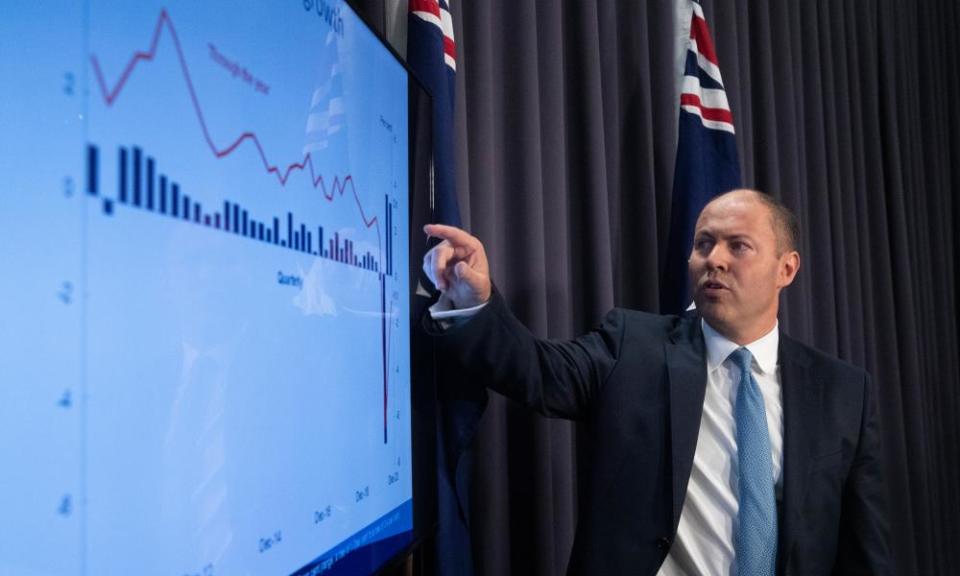Australia's economic recovery continues with 3.1% growth in December quarter

The Australian economy grew by 3.1% in the December quarter as the domestic recovery from the pandemic-induced shock consolidated.
The continued bounce back in growth late last year as coronavirus restrictions eased followed a 3.4% increase in GDP in the previous quarter. The September result followed a record 7% fall in GDP in June, triggered by the public health measures.
While the solid December quarter result suggests the economy is on a recovery path, in annual terms, there has been a 1.1% fall in GDP.
The Australian Bureau of Statistics reported that GDP per capita was also weaker, falling 1.8%, reflecting a 0.7% rise in population. The economic recovery, while exceeding market expectations and previous economic forecasts, was also partial.
Related: The optimism of Australia's investors for the future has shot through the roof | Greg Jericho
Speaking to reporters in Canberra, the treasurer, Josh Frydenberg, said this was “the first time in recorded history that Australia has seen two consecutive quarters of economic growth of more than 3%”.
He said the December quarter figures indicated the economy had recovered 85% of its “Covid-induced fall, six months earlier and twice as fast as we expected in last year’s October budget”.
“This is a very encouraging performance from the Australian economy, given the economic abyss that we were staring into at the peak of this crisis,” Frydenberg said.
The positive result in the September quarter was driven by a 4.7% increase in the terms of trade, reflecting high export prices for iron ore.
Final consumption expenditure also contributed 2.3% to the quarterly growth result. Spending by households rose 4.3% the September quarter, but it remained subdued in annual terms. Spending was down 2.7% in the year.
The savings ratio hit record levels during the pandemic, but the data suggested consumers were cautiously returning to the fray. The household saving-to-income ratio declined to 12.0% from 18.7% in September.
The ratio remained at elevated levels, and the quarterly result reflected two factors – a cautious return to consumption, and falls in gross disposable income as the Morrison government withdrew fiscal support, tapering the jobkeeper wage subsidy and the jobseeker payment.
Victoria was part of the consumption story. As the state moved out of stage four lockdown, consumption by households increased by 10.4%, which replicated activity during the previous quarter for households outside Victoria.
The Australian Bureau of Statistics noted spending on goods was up by more than 6% in annual terms, and 2.8% in the quarter.
Related: Labor asks for investigation into $30m jobkeeper payments to Qube despite earnings increase
Rather than heading overseas for holidays, Australians seemed to be buying vehicles, with spending up a record 31.8%. The ABS said this was the largest rise in the history of the national accounts. It said the expenditure reflected “elevated household disposable income and shifting spending patterns with continued limitations on some expenditure items such as international travel”.
Private investment recorded its strongest result since the September quarter in 2017. Activity in the housing market was strong, and a rise in business investment during the December quarter was driven by an 8.9% increase in machinery and equipment, reflecting government tax incentives to stimulate the economy.
The farm sector also enjoyed favourable conditions. An increase in agricultural production during the quarter flowed through to a 23.5% increase in rural exports.
But the hospitality sector recorded unprecedented falls in activity because of the impact of the January bushfire crisis and the Covid-19 restrictions. Over the past 12 months, household consumption of hotels, cafes and restaurants fell by almost 30% and consumption of transport services was down 78.1%.
Frydenberg said the latest data showed the government’s economic recovery plan was “working”, but he acknowledged the “job is not done”.
“There are challenges ahead – but you wouldn’t want to be in any other country but Australia as we begin 2021”.

 Yahoo Movies
Yahoo Movies 